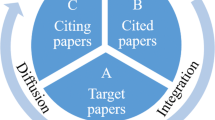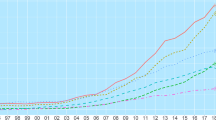Abstract
Here we show a comparison of top economics departments in the US and EU based on a summary measure of the multidimensional prestige of influential papers in 2010. The multidimensional prestige takes into account that several indicators should be used for a distinct analysis of structural changes at the score distribution of paper prestige. We argue that the prestige of influential articles should not only consider one indicator as a single dimension, but in addition take into account further dimensions, since several different indicators have been developed to evaluate the impact of academic papers. After having identified the multidimensionally influential articles from an economics department, their prestige scores can be aggregated to produce a summary measure of the multidimensional prestige of research output of this department, which satisfies numerous properties.

Similar content being viewed by others
References
Alkire, S., & Foster, J. (2008). Counting and multidimensional poverty measurement, Working Paper No. 7. Oxford Poverty and Human Development Initiative (OPHI).
Bollen, J., Rodriguez, M. A., & van de Sompel, H. (2006). Journal status. Scientometrics, 69(3), 669–687.
Davies, J. B., Kocher, M. G., & Sutter, M. (2008). Economics research in Canada: A long-run assessment of journal publications. Canadian Journal of Economics, 41(1), 22–45.
Dridi, C., Adamowicz, W. L., & Weersink, A. (2010). Ranking of research output of agricultural economics departments in Canada and selected US universities. Canadian Journal of Agricultural Economics, 58, 273–282.
Dusansky, R., & Vernon, C. J. (1998). Rankings of U.S. economics departments. Journal of Economic Perspectives, 12(1), 157–170.
Garcia, J. A., Rodriguez-Sanchez, R., & Fdez-Valdivia, J. (2011a). Overall prestige of journals with ranking score above a given threshold. Scientometrics, 89(1), 229–243.
Garcia, J. A., Rodriguez-Sanchez, R., & Fdez-Valdivia, J. (2011b). Ranking of the subject areas of Scopus. Journal of the American Society for Information Science and Technology, 62(10), 2013–2023.
Garcia, J. A., Rodriguez-Sanchez, R., Fdez-Valdivia, J., & Martinez-Baena, J. (2011c). On first quartile journals which are not of highest impact. Scientometrics, 90(3), 925–943.
Garfield, E. (2006). The history and meaning of the journal impact factor. JAMA—Journal of the American Medical Association, 295(1), 90–93.
González-Pereira, B., Guerrero-Bote, V. P., & Moya-Anegón, F. (2010). A new approach to the metric of journals’ scientific prestige: The SJR indicator. Journal of Informetrics, 4(3), 379–391.
Hirsch, J. E. (2005). An index to quantify an individual’s scientific research output. PNAS, 102(46), 16569–16572.
Journal Citation Reports. (2011). Thomson Reuters. http://thomsonreuters.com/products_services/science/science_products/a-z/journal_citation_reports/. Accessed November 2011.
Kalaitzidakis, P., Stengos, T., & Mamuneas, T. P. (2003). Rankings of academic journals and institutions in economics. Journal of the European Economic Association, 1(6), 1346–1366.
Kinnucan, H. W., & Traxler, G. (1994). Ranking agricultural economics departments by AJAE page counts: A reappraisal. Agricultural and Resource Economics Review, 23(2), 194–199.
Laband, D. N., & Zhang, D. (2006). Citations, publications, and perceptions-based rankings of the research impact of North American forestry programs. Journal of Forestry, 104(5, July/August), 254–261.
Leydesdorff, L., Moya-Anegón, F., & Guerrero-Bote, V. P. (2010). Journal maps on the basis of Scopus data: A comparison with the Journal Citation Reports of the ISI. Journal of the American Society for Information Science and Technology, 61(2), 352–369.
Lubrano, M., Kirman, A., Bauwens, L., & Protopopescu, C. (2003). Ranking economics departments in Europe: A statistical approach. Journal of the European Economic Association, 1(6), 1367–1401.
Peichl, A., & Pestel, N. (2010). Multidimensional measurement of richness: Theory and an application to Germany. IZA Discussion Paper, No. 4825.
Peichl, A., Schaefer, T., & Scheicher, C. (2008). Measuring richness and poverty: A micro data application to Europe and Germany. IZA Discussion Paper No. 3790.
Rousseau, S., Verbeke, T., & Rousseau, R. (2008). Evaluating environmental and resource economics journals: A TOP-curve approach. Review of Environmental Economics and Policy, 3(2), 270–287.
SCImago Journal and Country Rank. SCImago Research Group. http://www.scimagojr.com. Accessed November 2011.
Scopus Website. (2011). http://www.scopus.com. Accessed November 2011.
Sen, A. (1976). Poverty: An ordinal approach to measurement. Econometrica, 44(2), 219–231.
Takayama, N. (1979). Poverty, income inequality, and their measures: Professor Sen’s axiomatic approach reconsidered. Econometrica, 47(3), 747–759.
Acknowledgments
This research was sponsored by the Spanish Board for Science and Technology (MICINN) under grant TIN2010-15157 cofinanced with European FEDER funds. Thanks are due to the reviewers for their constructive suggestions.
Author information
Authors and Affiliations
Corresponding author
Electronic supplementary material
Below is the link to the electronic supplementary material.
Appendix 1: dimensions of the multivariate indicator space
Appendix 1: dimensions of the multivariate indicator space
The impact factor, often abbreviated IF, is a measure reflecting the average number of citations to articles published in science and social science journals. It is frequently used as a proxy for the relative importance of a journal within its field, with journals with higher impact factors deemed to be more important than those with lower ones. The impact factor was devised by Eugene Garfield (Garfield 2006), the founder of the Institute for Scientific Information (ISI), now part of Thomson Reuters. Impact factors are calculated yearly for those journals that are indexed in Thomson Reuter’s Journal Citation Reports.
The SCImago Journal Rank (SJR) (González-Pereira et al. 2010), presents an indicator of “journal prestige" (Bollen et al. 2006), that belongs to a new family of indicators based on eigenvector centrality. The SJR indicator is a size-independent metric aimed at measuring the current “average prestige per paper" of journals for use in research evaluation processes. It has already been studied as a tool for evaluating the journals in Scopus, compared with the Thomson Scientific Impact Factor and shown to constitute a good alternative for journal evaluation, (Leydesdorff et al. 2010).
The ES calculation is based on the number of times articles from the journal published in the past 5 years have been cited in the JCR year, but it also considers which journals have contributed these citations so that highly cited journals will influence the network more than lesser cited journals, (Journal Citation Reports 2011). References from one article in a journal to another article from the same journal are removed, so that ESs are not influenced by journal self-citation.
The Article Influence determines the average influence of articles in a journal over the first 5 years after publication, (Journal Citation Reports 2011). It is calculated by dividing a journal’s ES by the number of articles in the journal, normalized as a fraction of all articles in all publications. This measure is roughly analogous to the 5-Year Journal Impact Factor in that it is a ratio of a journal’s citation influence to the size of the journal’s article contribution over a period of 5 years.
The H-index attempts to measure both the productivity and impact of the published work of a scientist or scholar. The index is based on the set of the scientist’s most cited papers and the number of citations that they have received in other publications. The index can also be applied to the productivity and impact of a department or university or country or journal. The index was suggested by Jorge E. Hirsch, a physicist at UCSD, as a tool for determining theoretical physicists’ relative quality, (Hirsch 2005), and is sometimes called the Hirsch index or Hirsch number. In our analysis, the H-index expresses the journal’s number of articles (h) that have received at least h citations over the whole period. The H-index for each journal in a subject category was computed as given in the SCImago Journal and Country Rank portal (available at: http://www.scimagojr.com).
An II is a measure of how topical and urgent work published in a scientific journal is. Along with the better known impact factor measure, it is calculated each year by the Institute for Scientific Information for those journals which it indexes; both impact factors and immediacy indices are published annually in the Journal Citation Reports, (Journal Citation Reports 2011).
Rights and permissions
About this article
Cite this article
García, J.A., Rodriguez-Sánchez, R. & Fdez-Valdivia, J. A comparison of top economics departments in the US and EU on the basis of the multidimensional prestige of influential articles in 2010. Scientometrics 93, 681–698 (2012). https://doi.org/10.1007/s11192-012-0708-7
Received:
Published:
Issue Date:
DOI: https://doi.org/10.1007/s11192-012-0708-7




